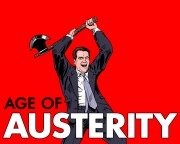THE GUARDIAN: In 2011 Congress was engaged in a bitter battle over the direction of the US economy; a group of them seemed ready to default on the nation’s debt and shut down the government, if necessary, to win their point: that the growing federal deficit would endanger America’s economy for generations to come. Others were unconvinced. The stalemate brought Washington to a standstill on the issue. During this tense period, there was an important meeting. Nearly 40 Senators sat in neat rows to hear a presentation on debt from Carmen Reinhart and Ken Rogoff, two economists with faultless reputations and keen academic credentials. They were not just economists that day, however, bolstered by years of research and a 900-pound book full of graphs and complex economic data, Reinhart and Rogoff were also activists against debt. Their goal was to convince the assembled lawmakers to cut the amount of money the government owed.
The data from Reinhart and Rogoff showed that if the national debt became equivalent to 90% of the US gross domestic product, the US would suffer low growth and all that comes with it: unemployment,  malaise, poverty. Reinhart and Rogoff had faultless authority; in 2009, they had published a 900-page doorstopper of a book full of graphs and charts dryly titled This Time It’s Different. Reinhart and Rogoff wrote in the introduction:
malaise, poverty. Reinhart and Rogoff had faultless authority; in 2009, they had published a 900-page doorstopper of a book full of graphs and charts dryly titled This Time It’s Different. Reinhart and Rogoff wrote in the introduction:
“What is certainly clear is that again and again, countries, banks, individuals, and firms take on excessive debt in good times without enough awareness of the risks that will follow when the inevitable recession hits. The fact that basic data on domestic debt are so opaque and difficult to obtain is proof that governments will go to great lengths to hide their books when things are going wrong, just as financial institutions have done in the contemporary financial crisis.
We hope that the weight of evidence in this book will give future policy makers and investors a bit more pause before next they declare, ‘This time is different.’ It almost never is.”
That anti-debt message was what occasioned their trip to Washington. Rogoff and Reinhart were there to encourage the lawmakers to cut the deficit at any cost, including severe government downsizing. The implication of their presentation was clear: if you think this economy is bad, if you’re already hearing from your jobless constituents, wait until you’ve been suffering through it for 10 more years or more. One can picture the thought bubbles above the senators’ heads: they could likely not help but be concerned about their ability to make the right decisions about the economy and hold office if they didn’t cut debt. Rogoff and Reinhart were not  there to just present their conclusions; they were there to lobby for them. Senator Tom Coburn, a Republican from Oklahoma, who was there, described the scene and the conversation:
there to just present their conclusions; they were there to lobby for them. Senator Tom Coburn, a Republican from Oklahoma, who was there, described the scene and the conversation:
“A key conclusion of [Rogoff and Reinhart’s work] is that economies like ours slow down considerably when our debt-to-GDP ratio reaches about 90% (we are now at debt-to-GDP ratio of 100%).
Johnny Isakson, a Republican from Georgia and always a gentleman, stood up to ask his question: ‘Do we need to act this year? Is it better to act quickly?’‘Absolutely,’ Rogoff said. ‘Not acting moves the risk closer,’ he explained, because every year of not acting adds another year of debt accumulation. ‘You have very few levers at this point,” he warned us.'”
Even the skeptical lawmakers couldn’t help but take this warning seriously, Coburn indicated. Their moods shifted, indicating deep worry, as Coburn tells it:
“‘Thank you for your depressing presentation,’ Senator Dick Durbin, D-Ill., said in closing, to self-conscious laughter around the room.”
Coburn himself was so convinced that he became a leader of the anti-debt movement in Congress. He wrote a book titled The Debt Bomb: A Bold Plan to Stop Washington from Bankrupting America. This week, here’s what we found out: that very convincing data that Reinhart and Rogoff presented was wrong. Their research was messily done with spreadsheet errors. Here’s the gist: Reinhart and Rogoff said that economies with more than 90% debt have economic growth of -.1%, which would put them at risk of recessions.
In fact, new research finds, those countries grow their economies by 2.2% a year. To put that in perspective, that’s more growth than the US has had for quite a while. Rogoff and Reinhart’s research on debt and austerity finally collapsed under scrutiny of a team from the  University of Massachusetts-Amherst, which received the numbers from the economists. Reinhart and Rogoff replied, saying, in essence that some of their data may have been wrong, but their gist was right. This isn’t exactly satisfying. If the numbers aren’t really right, why would the conclusion be correct? MORE
University of Massachusetts-Amherst, which received the numbers from the economists. Reinhart and Rogoff replied, saying, in essence that some of their data may have been wrong, but their gist was right. This isn’t exactly satisfying. If the numbers aren’t really right, why would the conclusion be correct? MORE
THE ATLANTIC: What a difference an Excel coding error makes. Austerity has been a policy in search of a justification ever since it began in 2010. Back then, policymakers decided it was time for policy to go back to “normal” even though the economy hadn’t, because deficits just felt too big. The only  thing they needed was a theory telling them why what they were doing made sense. Of course, this wasn’t easy when unemployment was still high, and interest rates couldn’t go any lower. Alberto Alesina and Silvia Ardagna took the first stab at it, arguing that reducing deficits would increase confidence and growth in the short-run. But this had the defect of being demonstrably untrue (in addition to being based off a naïve reading of the data). Countries that tried to aggressively cut their deficits amidst their slumps didn’t recover; they fell into even deeper slumps.
thing they needed was a theory telling them why what they were doing made sense. Of course, this wasn’t easy when unemployment was still high, and interest rates couldn’t go any lower. Alberto Alesina and Silvia Ardagna took the first stab at it, arguing that reducing deficits would increase confidence and growth in the short-run. But this had the defect of being demonstrably untrue (in addition to being based off a naïve reading of the data). Countries that tried to aggressively cut their deficits amidst their slumps didn’t recover; they fell into even deeper slumps.


